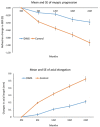Defocus Incorporated Multiple Segments (DIMS) spectacle lenses slow myopia progression: a 2-year randomised clinical trial
- PMID: 31142465
- PMCID: PMC7041503
- DOI: 10.1136/bjophthalmol-2018-313739
Defocus Incorporated Multiple Segments (DIMS) spectacle lenses slow myopia progression: a 2-year randomised clinical trial
Abstract
Aim: To determine if 'Defocus Incorporated Multiple Segments' (DIMS) spectacle lenses slow childhood myopia progression.
Methods: A 2-year double-masked randomised controlled trial was carried out in 183 Chinese children aged 8-13 years, with myopia between -1.00 and -5.00 D and astigmatism ≤1.50 D. Children were randomly assigned to wear DIMS (n=93) or single vision (SV) spectacle lenses (n=90). DIMS lens incorporated multiple segments with myopic defocus of +3.50 D. Refractive error (cycloplegic autorefraction) and axial length were measured at 6month intervals.
Results: 160 children completed the study, n=79 in the DIMS group and n=81 in the SV group. Average (SE) myopic progressions over 2 years were -0.41±0.06 D in the DIMS group and -0.85±0.08 D in the SV group. Mean (SE) axial elongation was 0.21±0.02 mm and 0.55±0.02 mm in the DIMS and SV groups, respectively. Myopia progressed 52% more slowly for children in the DIMS group compared with those in the SV group (mean difference -0.44±0.09 D, 95% CI -0.73 to -0.37, p<0.0001). Likewise, children in the DIMS group had less axial elongation by 62% than those in the SV group (mean difference 0.34±0.04 mm, 95% CI 0.22 to 0.37, p<0.0001). 21.5% children who wore DIMS lenses had no myopia progression over 2 years, but only 7.4% for those who wore SV lenses.
Conclusions: Daily wear of the DIMS lens significantly retarded myopia progression and axial elongation in myopic children. Our results demonstrated simultaneous clear vision with constant myopic defocus can slow myopia progression.
Trial registration number: NCT02206217.
Keywords: myopia; myopia control; myopic defocus; simultaneous vision; spectacle lens.
© Author(s) (or their employer(s)) 2020. Re-use permitted under CC BY-NC. No commercial re-use. See rights and permissions. Published by BMJ.
Conflict of interest statement
Competing interests: None. Patents titled ‘Spectacle Lens' in China (CN104678572 B) and in USA (US10268050 B2) were issued on 27 April 2018 and 23 April 2019 respectively.
Figures



Comment in
-
Association between choriocapillaris perfusion and axial elongation in children using defocus incorporated multiple segments (DIMS) spectacle lenses.Eye (Lond). 2023 Dec;37(18):3847-3853. doi: 10.1038/s41433-023-02629-2. Epub 2023 Jun 27. Eye (Lond). 2023. PMID: 37369765 Free PMC article.
References
Publication types
MeSH terms
Associated data
LinkOut - more resources
Full Text Sources
Other Literature Sources
Medical
